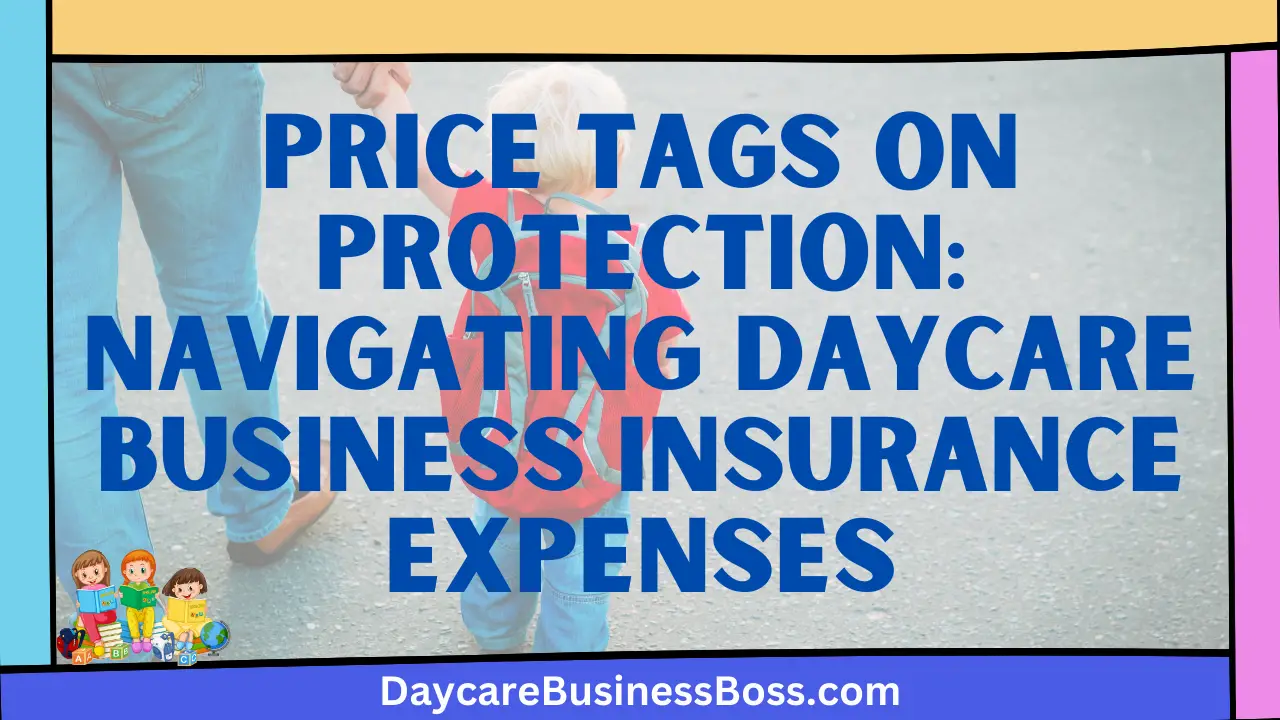Running a childcare business entails a unique mix of obstacles and obligations, and one critical factor that should not be missed is insurance coverage. Daycare company insurance protects against unanticipated incidents and liabilities that can occur when running a daycare center. The cost of daycare company insurance, on the other hand, is not a one-size-fits-all equation.
The best way to determine the cost of daycare business insurance is to consider several factors, including the size of the facility, location, number of children, services offered, and specific coverage needs. On average, in the U.S., daycare insurance can range from $450 to $1,350 annually for basic coverage.
In this article, we will delve into the subject of daycare company insurance costs, putting light on the various elements that contribute to this necessary investment. Understanding the complexities of insurance prices as a daycare provider is a strategic decision that affects the longevity and resilience of your organization.
Size of the Facility

The size of your daycare establishment has a significant impact on the financial expenditure for insurance coverage. The size of the facility’s physical footprint is closely related to higher insurance prices. This is due to the increased risk exposure that comes with hosting a larger cohort of youngsters and staff members. Underwriters thoroughly assess several features of the business, such as overall square footage, the number of unique classes, play areas, and communal zones.
The calculation is simple: a larger daycare facility may have a higher risk of accidents or unpleasant incidents. As a result, insurance coverage must be expanded to account for the anticipated increase in liabilities. As a result, owners of large daycare facilities should brace themselves for increased insurance costs, a critical step in properly protecting their business from potential lawsuits and financial implications.
The size of a daycare center has a repercussion on risk assessment. A larger space means more foot traffic, more activities, and a more complex network of interactions, all of which can increase the probability of an accident. Whether it’s a slip-and-fall occurrence in a play area or a disaster during an organized activity, the facility’s vastness broadens the range of possible difficulties. Insurance companies, acutely aware of this fact, tailor their coverage costs appropriately.
When it comes to insurance, daycare owners must evaluate the size of their facility as a critical variable. Insurance costs can be viewed as a strategic investment, a necessary safeguard against unforeseen liabilities that may arise in the frenetic environment of a thriving daycare center. In essence, as the square footage grows, so does the potential for incidents, confirming the inextricable link between the facility’s dimensions and the financial security that comprehensive insurance coverage provides.
Read more about: Spectrum Support: Initiating an Autism-Focused Daycare Facility
Location
The phrase “location is everything” rings true when it comes to daycare insurance premiums. The geographical backdrop against which your daycare business operates has a significant impact on the monetary outlay of insurance premiums. This is not a random decision, but rather a reflection of the complex interplay between local dynamics and financial security. When determining your premiums, insurance companies, as watchful evaluators, methodically examine a plethora of criteria fundamental to your operating region.
Local regulations, such as the geography of the terrain, are critical in this calculation. These regulations differ from one jurisdiction to the next, comprising a wide range of requirements that govern the operational framework of daycare facilities. Insurance firms, aware of the regulatory matrix, include these standards in their calculations, as adherence or deviation from them might affect your company’s risk profile.
Another important driver is crime rates, which are analogous to regional currents. Because of the higher population density, urban places, pulsing with life and humanity, can sometimes bear witness to elevated crime rates. This increase in criminal activities may increase insurance prices. With its keen observation, the insurance sector considers these figures and uses them as risk factors that underpin the pricing structure.
Another aspect that insurers scrutinize is the environment in which your daycare business develops. Natural disaster-prone areas, such as floods, earthquakes, or hurricanes, present a unique set of issues. Insurance premiums are adjusted to account for these environmental hazards, indicating the higher coverage needed to protect against nature’s erratic behavior.
Number of Children
The number of children enrolled in your daycare facility appears as a crucial element in determining the landscape of insurance prices. This numerical quotient, a key component of your operational structure, has a direct impact on insurance carriers’ financial calculations. Their precise calculations focus on a critical confluence: the child-to-staff ratio and the complex dance between probable events and accidents.
The child-to-staff ratio, which is similar to a delicate balance, is significant as an indicator of the level of supervision and care provided to each child. In their careful analysis, insurance firms recognize that a smaller ratio often equates to a more meticulous watch over the children, potentially decreasing the danger of accidents. This dynamic, together with the overall enrollment number, is the foundation upon which the cost of coverage is built.
The inherent risk potential increases as the numbers grow. A larger number of youngsters converging inside the daycare’s zone of influence increases the statistical likelihood of mishaps. Accidents while playing, unplanned incidents, or minor injuries – the list of possibilities grows exponentially. Insurance rates, like a carefully calibrated scale, adjust to account for the expanding spectrum of potential liabilities.
In this equation, precision is critical. It becomes a non-negotiable precept to report the exact number of youngsters entrusted to your care to your insurance provider. Underestimation has far-reaching and harsh effects. When faced with a real-world claim scenario, an undervaluation of the child count can result in insurance coverage that falls short. The financial ramifications of such a mistake could echo throughout your daycare operation, putting undue strain on your resources.
Services Offered

Your childcare business’s scope of services reverberates as a vital factor, creating ripples across the sphere of insurance costs. Beyond the fundamental daycare activities, the menu of services you provide ingeniously weaves itself into the calculus used by insurance carriers to adjust premiums. A significant revelation dawns on daycare owners: each supplementary service introduces its own set of possible hazards, necessitating a complete coverage strategy to manage the tangled web of obligations.
Consider the canvas to be enhanced by extra services such as transportation, swimming lessons, and exciting field trips that add color to the tapestry of your daycare offerings. Each of these service branches provides a new set of risk elements, a slew of unknowns that pose new hurdles. The wheels of a transportation service turn not only with the promise of ease but also with the threat of road accidents. Swimming lessons, although promoting aquatic confidence, also raise the possibility of poolside catastrophes. And the attractiveness of field trips, with their seduction of experiencing learning, is intertwined with the susceptibility to mishaps in unfamiliar settings.
Based on this broad spectrum, insurance carriers, like astute artisans, construct a nuanced picture of coverage. Premiums are dynamic modifications that match the shifting contours of your daycare’s service landscape in this orchestration. While these services increase the experience of the children in your care, they necessitate an insurance umbrella that recognizes and accommodates the varied universe of potential hazards.
Read more about: In-Home Daycare Economics: Mastering the Yearly Cost Puzzle
Specific Coverage Needs
Like the intricate fabric of a customized garment, daycare company insurance is not a one-size-fits-all approach. Instead, it unfolds as a carefully made outfit, painstakingly adaptable to encapsulate the unique curves and peculiarities of each daycare facility. The canvas of coverage within this arena stretches far beyond the fundamental standards, leading daycare operators into a domain of strategic thought that takes into account the various subtleties of risk management.
Beyond the fundamental layers, there is a plethora of supplemental coverage alternatives that entice discriminating daycare owners. General liability, a broad shield against a wide range of legal claims; property damage, a guardian against the whims of unforeseen events; workers’ compensation, a guarantee of support in the face of employee injuries; and abuse or molestation coverage, a critical layer guarding against serious allegations.
Each option, a thread of security sewn into the fabric of insurance, has a financial resonance. The breadth and depth of your coverage correspond to the symphony of cost escalation. However, it is within this framework of choice that childcare entrepreneurs exercise their strategic discernment. The compass guiding this decision-making trip is an introspective assessment of the particular tapestry of hazards your daycare business faces.
The procedure turns into a hunt for equilibrium – a balance between extensive coverage and the financial limits of your daycare operation. The key is to recognize that specialized protection comes at an additional cost, one that is a strategic investment in your company’s future. The fitted ensemble of insurance coverage, like a signature suit, displays not just the scope of your daycare’s operations, but also your dedication to preparedness.
Understanding Average Costs
The tapestry of daycare insurance costs throughout the great breadth of the United States is weaved with a spectrum that normally extends from $450 to $1,350 annually for basic coverage. While acting as a foundational reference point, this numerical distinction reveals the changing character of daycare insurance. It resonates with the prior symphony of concerns, a medley that orchestrates the ultimate tune of expenditures for each childcare owner.
Despite this numerical backdrop, a fundamental notion emerges: the uniqueness of your daycare’s situation serves as the pivot around which costs pivot. A customized pricing structure for your insurance coverage is created by combining characteristics such as location, facility size, services supplied, and enrollment numbers. This individualized dimension emphasizes the fact that, while averages provide a foundation, your daycare’s insurance adventure unfolds against a backdrop of specific characteristics.
As you embark on this trip, you will come across a plethora of quotes, each of which provides insight into the pricing tactics of various insurance providers. The range of these quotes reflects the complexity of the insurance landscape. Dissecting these variances and discerning the cost mosaic can evolve into a strategic activity, one that sifts through the details to discover the provider that provides the ideal balance of cost and coverage.
The secret to this tapestry of quotes is judgment. As a daycare owner, your responsibility shifts to that of an astute evaluator. You study the architecture of these charges, comprehending the components that culminate in the ultimate price tag, beyond the surface figures. The symphony of coverage, services, and potential liabilities is transformed into a score that can be studied, interpreted, and compared.
Frequently Asked Questions

What factors influence the price of daycare business insurance?
Several important factors influence the cost of daycare business insurance. These factors include the facility’s size, location, the number of children enrolled, the breadth of services provided, and your unique coverage requirements. Higher premiums are often associated with larger facilities, urban settings, and a greater number of children due to increased risk exposure. Additional services, such as transportation or swimming lessons, can raise fees. Customizing your coverage to your daycare’s specific risks is critical, but it may result in additional costs.
What is the average cost of daycare insurance in the United States?
In the United States, the cost of basic daycare insurance ranges from $450 to $1,350 per year. However, this average is only a starting point and will vary depending on the aforementioned criteria. The size, location, services, and coverage requirements of your daycare will all influence the final cost. To acquire an accurate quotation tailored to your circumstances, gather numerous quotes from insurance providers.
Why is it critical for daycare entrepreneurs to seek various insurance quotes?
Daycare operators must obtain many insurance estimates to guarantee they are obtaining the greatest coverage at the best price. Insurance companies use various underwriting criteria, risk assessments, and pricing models. By comparing quotations from various providers, you may determine which one provides the best value for your daycare’s specific needs. This procedure enables you to make an informed selection and avoid overpaying for coverage that may not be appropriate for your company.
To learn more on how to start your own daycare checkout my startup documents here.
The information provided by DaycareBusinessBoss.com (“The Site”) is for general informational purposes only. All information on the Site is provided in good faith, however, we make no representation or warranty of any kind, express or implied, regarding the accuracy, adequacy, validity, reliability, availability or completeness of any information on the Site. Under no circumstance shall we have any liability to you for any loss or damage of any kind incurred as a result of the use of the Site or Reliance on any information provided on the Site. Your use of the Site and your reliance on any information on the Site is solely at your own risk.
This blog post is for educational purposes only and does not constitute legal advice. Please consult a legal expert to address your specific needs. Terms and Conditions. (https://daycarebusinessboss.com/terms-conditions/)

Meet Shawn Chun: Entrepreneur and Childcare Business Fan.
I’m a happy individual who happens to be an entrepreneur. I have owned several types of businesses in my life from a coffee shop to an import and export business to an online review business plus a few more and now I create online daycare business resources for those interested in starting new ventures. It’s demanding work but I love it. I do it for those passionate about their business and their goals. That’s why when I meet a childcare business owner, I see myself. I know how hard the struggle is to retain clients, find good employees and keep the business growing all while trying to stay competitive.
That’s why I created Daycare Business Boss: I want to help childcare business owners like you build a thriving business that brings you endless joy and supports your ideal lifestyle.


